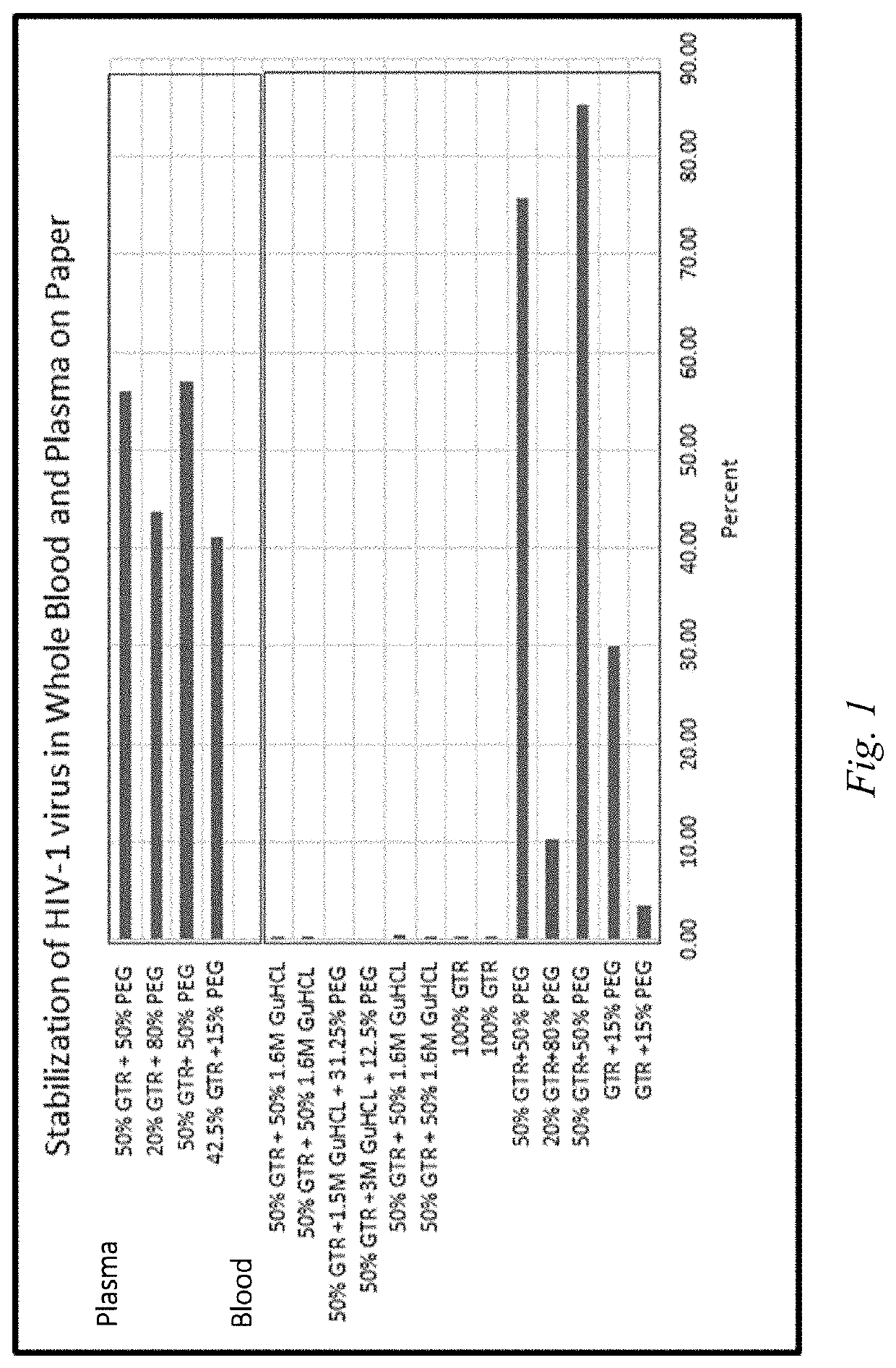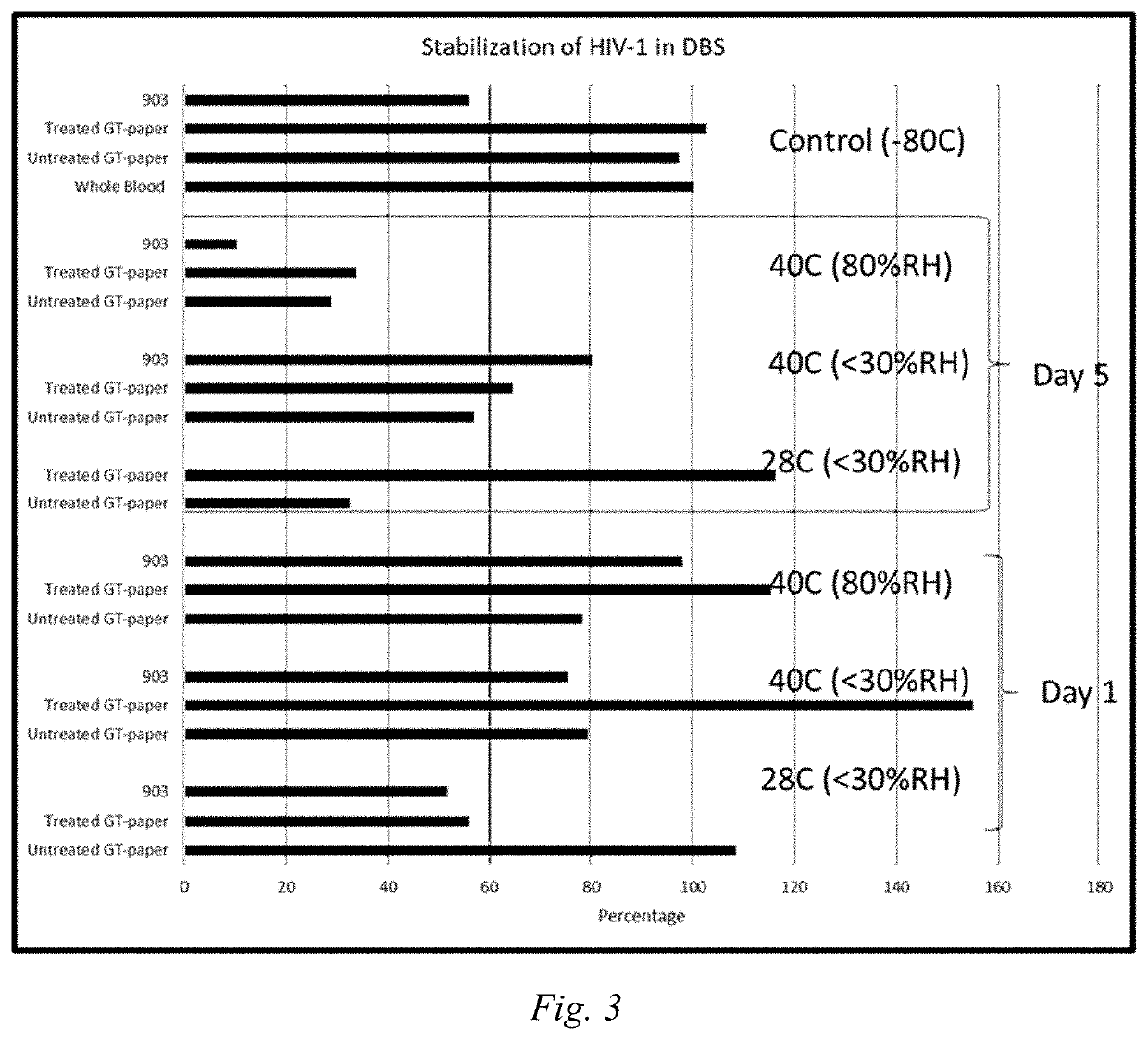Matrices and methods for storage and stabilization of biological samples comprising viral RNA
a biological sample and matrix technology, applied in the field of viral rna, can solve the problems of false negative diagnosis, too high analysis volume, and too expensive systems, and achieve the effects of high volume, high throughput, and time-consuming and/or laborious
- Summary
- Abstract
- Description
- Claims
- Application Information
AI Technical Summary
Benefits of technology
Problems solved by technology
Method used
Image
Examples
example 1
[0091]The compositions of the present application were evaluated for their ability to stabilize HIV-1 virus present in both whole blood and plasma on paper. The whole blood and plasma were provided in a solid state, in the form of dried plasma spots (DPS) and dried blood spots (DBS). To further evaluate the effect of PEG as a cell separation reagent, various weight percentages of PEG-600 were evaluated. In particular, PEG-600 was evaluated at weight percentages of 15%, 50%, and 80% in the stabilization of DPS. For DBS, PEG was evaluated at 12.5%, 15%, 31.25%, 50% and 80% PEG.
[0092]The effect of PEG in the formulations of the present application were compared to a control comprising the other components of composition according to the application but excluding PEG, and to a comparative formula using Guanidium chloride (GuHCl), a denaturing chaotropic agent, in place of PEG. These formulations can be shown in Table 1 below, wherein Formulation 1 represents the formulation according to...
example 2
[0095]The experimental procedures of Example 1 were repeated, except that the stabilization of HIV-1 virus was evaluated for whole blood and plasma in solution. In addition to the formulations and compositions in Table 1, further controls were added. The additional controls in this case were a solution of HIV-1 virus and blood only, the HIV-1 virus and water only, and finally the HIV-1 virus and plasma only. These controls contained 210,000 copies / mL of the HIV virus, spiked in 30 uL whole blood, plasma, or water. These controls were stored at −80° C., mimicking currently existing storage procedures. Like Example 1, the preservation and storage efficacy are expressed in terms of percent recovery. The results of this evaluation are shown in FIG. 2.
[0096]FIG. 2 shows that for samples stored in solution, the presence of PEG is important for the successful storage and recovery of the HIV-1 virus in solution.
example 3
[0097]The test procedures of Example 1 were repeated, except that the samples evaluated were 903, paper treated according to formulation 1 of table 1, untreated paper, and whole blood. These samples where then applied to paper and dried as DBS samples according to Example 1. The DBS samples were dried at 72 C for 2 hours followed by storage for 1 day and 5 days at either 40 C with 80% relative humidity, 40 C with <30% relative humidity or at ambient temperature of 28 C with <30% relative humidity. Representative control DBS samples on 903 paper, untreated GT-paper and GT-paper treated with formulation 1 and control liquid whole blood samples were stored at −80 C. At the end of the 1 day and 5 day incubation periods, the experimental and control DBS samples were rehydrated with nuclease free water to the original volume of the sample applied to the DBS and analyzed with the COBAS® TaqMan® HIV-1 Test. The results of this evaluation are shown in FIG. 3.
[0098]FIG. 3 shows that the treat...
PUM
| Property | Measurement | Unit |
|---|---|---|
| temperature | aaaaa | aaaaa |
| temperature | aaaaa | aaaaa |
| temperature | aaaaa | aaaaa |
Abstract
Description
Claims
Application Information
 Login to View More
Login to View More - R&D
- Intellectual Property
- Life Sciences
- Materials
- Tech Scout
- Unparalleled Data Quality
- Higher Quality Content
- 60% Fewer Hallucinations
Browse by: Latest US Patents, China's latest patents, Technical Efficacy Thesaurus, Application Domain, Technology Topic, Popular Technical Reports.
© 2025 PatSnap. All rights reserved.Legal|Privacy policy|Modern Slavery Act Transparency Statement|Sitemap|About US| Contact US: help@patsnap.com



